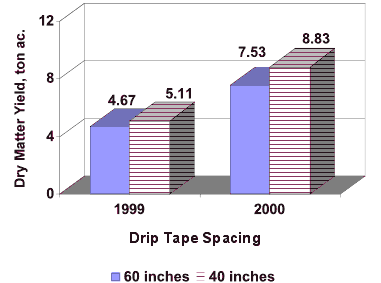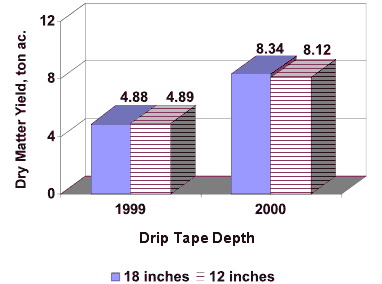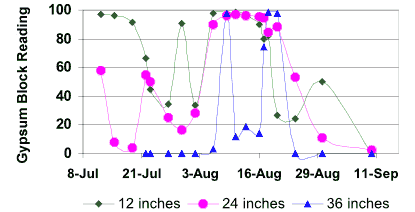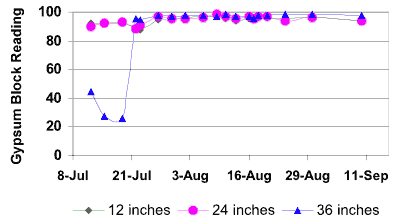June 2002 // Volume 40 // Number 3 // Research in Brief // 3RIB5
An Efficient Irrigation Technology for Alfalfa Growers
Abstract
A trial on the suitability of subsurface drip irrigation (SDI) for alfalfa (Medicago sativa L) was conducted on a producer's field. The soil is sandy loam. The treatments included drip tape spacing of 60, 40, and 30 inches, placed at 18- and 12-inch depth. A nearby center pivot sprinkler irrigated plot was seeded to alfalfa as a control. Seedling emergence and yield was adversely affected at 60-inch spacing. The depth of placement of drip tapes (18 and 12 inch) showed no effect. The site served for Extension education and allowed comparison between SDI tape spacing and center pivot system.
Background
Alfalfa (Medicago sativa L) acreage has been rising steadily in 13 western states of the U.S. The states with an increase are Arizona, Colorado, Idaho, Indiana, Kansas, Montana, Nevada, New Mexico, North and South Dakota, Texas, Utah, and Wyoming. More than a million acres have been added during the last decade (National Agriculture Statistics Service, USDA). Production agriculture in the arid western states predominantly depends on irrigation.
Alfalfa is a high water use crop. The consumptive use can exceed 46 inches. Most of this amount needs to be supplemented by irrigation, and an irrigation diversion of 30 to 36 inches is quite common. These western states depend on both surface water diversions and groundwater from wells. Agriculture is by far the biggest water user at this time. Competition for limited water resources is increasing for other uses such as industry, municipality, recreation, aquatic and wildlife habitat maintenance, etc.
The states depending on groundwater aquifers such as the Ogallala are experiencing declines in the water table. The cost of pumping is also going up due to rising energy costs. Thus, the efficient use of available water is necessary to produce a high water use crop such as alfalfa.
Techniques like surge irrigation and sprinklers have improved efficiency and conserved water. Producers are constantly looking for new technology to improve irrigation efficiency and reduce operating costs. Drip irrigation for arid climates has reduced water loss from evaporation, run-off, and deep percolation.
Drip irrigation has proven to be most effective for high dollar cash crops like fruits and vegetables. In Kansas, subsurface drip irrigation (SDI) has been shown to be a feasible technology for the irrigation of field crops like corn (Lamm, Manges, Stone, Khan, & Rogers, 1995). Economic studies for irrigated corn have shown that SDI is economically competitive to flood and center pivot irrigation systems for small fields and potentially competitive for larger fields (O'Brien, Rogers, Lamm, & Clark, 1998).
Subsurface drip irrigation is a viable alternative irrigation technology that offers the potential to reduce the amount of water used to irrigate alfalfa. Given the increased interest in alfalfa as a feed crop, research on SDI could provide needed information for irrigated alfalfa producers in the western United States. However, little information on the use of SDI for alfalfa is available in the scientific literature.
A previous study in California has shown increased alfalfa yield due to the use of SDI when compared to furrow irrigation (Hutmacher et al., 1992). One aspect of yield improvement is that the scalding of alfalfa leaves that can happen under sprinkler irrigation is reduced (Henggeler, 1995).
The critical stage to meet the water needs of alfalfa is after harvest when the crop starts regrowth. SDI allows irrigation to continue during or right after harvest to encourage quick regrowth. There is no need to suspend irrigation for a soil dry down period before harvest or while the hay is curing, since the water is applied below the soil surface.
The lack of surface wetting eliminates evaporation loss and helps reduce the competition from annual weeds that may germinate with surface wetting from sprinkler irrigation. The scope of losses due to deep percolation and surface evaporation is greatly reduced in SDI. Research from Kansas State University indicates that it is possible to save 25 percent of total water diverted in a season by using SDI in corn (Lamm et al., 1995).
Objectives
The objectives of the study reported here were to:
- Demonstrate SDI for alfalfa in a cooperator's field,
- Measure alfalfa dry matter yields for SDI drip tape spacings and depths,
- Compare yields of SDI to a nearby sprinkler-irrigated field, and
- Measure soil water content to observe the spread of water.
Materials and Methods
The SDI system was installed in the corner of a center pivot sprinkler irrigated cornfield. The site is located south of Garden City, Kansas, south of the Arkansas River valley. The soil belongs to the Otero-Ulysses complex and has undulating slopes. The soil texture is sandy loam. The field had been previously leveled for flood irrigation.
Drip tapes were plowed in using a deep shank ripper equipped with a tube guide in September 1998. The largest expense for an SDI system is the drip tape. The closer the spacing of the drip tapes, the more drip tapes are needed to irrigate a given area and thus the greater the cost for the system. The treatments were spacing and the depth of placement of drip tapes as follows:
- 60 inches spacing by 18 inches depth,
- 60 inches spacing by 12 inches depth,
- 40 inches spacing by 18 inches depth,
- 40 inches spacing by 12 inches depth,
- 30 inches spacing by 18 inches depth, and
- A nearby center pivot irrigated field that served as control.
Nelson drip tape of 7/8-inch diameter and 24-inch emitter spacing was installed. The emitter flow rate is 0.372 gallons hr-1 per emitter at 8 psi. A 200-mesh disk filter system provided by Rain Bird was installed to meet filtration requirements. Fluidyne vortex flow meters operated by 12-volt DC batteries were installed along with a solar panel for continuous recharging.
Alfalfa was seeded using 6-inch row spacing in the fall of 1998. Yield data was collected in 1999 and 2000. Four harvest samples were collected from each of the six treatment plots to obtain dry matter yield. An area of 11 ft2 was harvested as a sample. The harvest samples were hand clipped during the growing season. The harvest area was randomly selected across the block.
Gypsum block soil water sensors were installed at the midpoint between two laterals to monitor the spread of water. The depth of placement was at 12, 24, and 36 inches below the soil surface. The soil water readings provided insight as to the distance of water movement away from the drip tape.
Results
The climate differed between 1999 and 2000. The first year of study started with a cool, wet spring, whereas the second year was hot and dry. The irrigation period was prolonged in 2000, and the numbers of harvest operations were five, compared to four in 1999. The results on water use and yields are presented separately by year.
1999
The total water budget from July 1 through September 29, 1999 was:
- Irrigation by
- SDI: 13.50 inches (average 0.15 inches/day)
- Sprinkler: 19.80 inches (average 0.22 inches/day)
- Rainfall: 6 inches
- Estimated modified Penman ET: 20.70 inches (average 0.23 inches/day)
Dry matter yields for 1999 are presented in Table 1. The results are non-replicated samples and therefore cannot be statistically compared.
Table 1.
Alfalfa Yields of SDI and Sprinkler Irrigated Plots
| Date of Harvest and Dry Matter Yield, ton ac.-1 |
||||||
|---|---|---|---|---|---|---|
| Treatment |
6-22-99 |
7-23-99 |
8-27-99 |
10-01-99 |
Total |
Total B* |
| 60 inch spacing (S) by 18 inch depth (D) |
1.90 |
0.62 |
1.14 |
0.94 |
4.60 |
2.08 |
| 60" (S) by 12" (D) |
1.51 |
0.92 |
1.36 |
0.94 |
4.73 |
2.30 |
| 40" (S) by 18" (D) |
1.65 |
1.06 |
1.20 |
1.25 |
5.16 |
2.45 |
| 40" (S) by 12" (D) |
1.73 |
1.04 |
1.25 |
1.03 |
5.05 |
2.28 |
| 30" (S) by 18" (D) |
1.48 |
1.00 |
0.86 |
1.12 |
4.46 |
1.98 |
| Sprinkler (Center Pivot) |
--- |
--- |
1.03 |
0.75 |
--- |
1.78 |
| *Total B--Total for last two harvests. | ||||||
The first two harvests for center pivot are not included, because of weed pressure during the initial harvest. Comparisons of corresponding total yields for the last two cuttings indicate a lower yield for sprinkler-irrigated alfalfa. The 40-inch drip tape spacing treatment with 18-inch depth of placement had the highest total yield at 5.16 ton ac.-1.
2000
The total water budget from May 10, 2000 through September 21, 2000 was:
- Irrigation by
- SDI: 21.5 inches (average 0.16 inches/day)
- Sprinkler: 25 inches (average 0.19 inches/day)
- Rainfall: 5.51 inches
- Estimated modified Penman ET: 41.76 inches (average 0.31 inches/day)
Dry matter yields of individual harvests within the 2000 season, including those from the sprinkler-irrigated center pivot field, are presented in Table 2. The 40-inch spacing treatment at 12-inch depth of placement had the highest total yield for the season at a little over 9 ton ac.-1. The center pivot sprinkler treatment yield was slightly lower than the 40-inch spacing treatments, but slightly higher than the 60-inch spacing treatments. Drip tape spacing of 30 inches showed no yield advantage over 40-inch spacing.
Table 2.
Dry Matter Yield of SDI and Sprinkler Irrigated Alfalfa for 2000
| Date of Harvest and Dry Matter Yield, ton ac.-1 |
||||||
|---|---|---|---|---|---|---|
| Treatment |
5-22-00 |
6-23-00 |
7-28-00 |
8-25-00 |
9-26-00 |
Total |
| 60 inches spacing (S) by 18 inches depth (D) |
2.34 |
1.57 |
1.83 |
1.14 |
1.10 |
7.98 |
| 60" (S) x 12" (D) |
2.18 |
1.45 |
1.42 |
1.13 |
1.00 |
7.18 |
| 40" (S) x 18" (D) |
2.40 |
1.90 |
1.74 |
1.40 |
1.21 |
8.65 |
| 40" (S) x 12" (D) |
2.61 |
1.63 |
2.05 |
1.38 |
1.35 |
9.02 |
| 30" (S) x 18" (D) |
2.70 |
1.61 |
1.58 |
1.30 |
1.27 |
8.46 |
| Sprinkler (Center Pivot) |
1.63 |
1.99 |
1.92 |
1.58 |
1.26 |
8.38 |
Figure 1.
Dry Matter Yield as Affected by Drip Tape Spacing

Figure 1 shows that, compared to the 60-inch spacing, the 40-inch drip tape spacing had a yield advantage of 0.44 and 1.25 tons ac.-1 for 1999 and 2000, respectively. The difference is perhaps due to having a cool and wet spring in 1999, but a hot and dry spring and summer in 2000. This indicates that the closer spacing would be more beneficial in dry years.
Hay quality tests were done for random samples taken from each block, and the analysis was done in an independent laboratory certified annually by the National Hay Testing Association. The average RFV for 40-inch spacing was 164 (good dairy quality hay), compared to 134 (dairy quality hay) for 60-inch spacing. The RFV value for center pivot irrigated field was also 134. Although the samples were obtained randomly, the irrigation trial was on blocks and non-replicated, and as such the results were not statistically compared.
Figure 2.
Dry Matter Yield as Affected by Depth of Drip Tape Placement

The yields from two different depth of placement of the drip tapes showed similar dry matter yields for both the years (Figure 2). Thus, the depth of placement had a little effect on yield.
Gypsum block meter readings for the 60-inch spacing and 18-inch depth treatment in 1999 are presented in Figure 3. The gypsum blocks were buried at 12, 24, and 36 inches in the root-zone located at the midpoint between the drip tapes. A reading of 99 to 95 indicates that the soil water status is between 85-100 percent of availability. A reading of 60 indicates that available soil water has fallen below 50 percent and requires replenishment.
It is evident from the data presented that the water level at the midpoint between two drip tapes for the 60-inch spacing treatment remained below optimum growing condition. The yield was lower, and "striping" appearance was visible.
Figure 3.
Gypsum Block Readings at the Midpoint for Drip Tape at 60-inch Spacing

Figure 4.
Gypsum Block Readings at the Midpoint for Drip Tape at 40-inch Spacing

Drip tape spacing of 40 inches placed at 12-inch depth provided a better water distribution for soils at 1- and 2-feet depths from the beginning of the season, and improved for soils at a 3-feet depth within a short period (Figure 4). Irrigation application amount was maintained at the same level for all treatments. A similar pattern of water distribution was observed in 2000 (data not presented due to space limitations).
Economic Implications
A net present value (NPV) analysis was completed to determine which SDI spacing was the best investment alternative for alfalfa, taking into account that SDI was economical to start with (O'Brien, et al., 1998). The major difference between the 40-inch and 60-inch drip tape spacing is the additional cost for closer spacing. Compared to the 60-inch spacing, the total length of drip tape required for the 40-inch spacing is increased by 4,356 ft per acre. The number of fittings required also increased. Consequently, the cost of the 40-inch spacing at $1,037 per acre is about $250 per acre more than the 60-inch spacing. However, yields were 0.44 to 1.25 ton ac-1 higher for the 40-inch spacing, and the relative feed value (RFV) was 30 points higher.
Given the higher cost of the 40-inch spacing, the NPV analysis indicates that the 40-inch spacing would need to yield about 0.75 tons ac-1 higher than 60-inch spacing in order to have an equal NPV. This assumes a 15-year useful life and an alfalfa price of $70 ton-1. As the length of useful life and (or) alfalfa price increases, the additional yield needed for the 40-inch spacing to equal the NPV of the 60-inch spacing decreases.
It is expected that an SDI system will last for 20 years under good management. The SDI systems installed at the Kansas State University Southwest and Northwest Research-Extension Centers are 11 years old and functioning without any symptom of plugging or deterioration (Lamm and Trooien, 1999).
Kansas county Extension agents used the field on which the research was conducted for educational tours, and as a result producers of four counties are now using SDI for alfalfa. This trial helped meet a need that was unavailable from traditional research. Research on alfalfa irrigation in a replicated random design demands resources in terms of land, equipment, labor, and funding. This trial has shown that Extension professionals may fill in with the help of innovative and cooperative producers.
Summary
Alfalfa emergence was affected adversely at the 60-inch spacing for this site with sandy loam soil. Some uneven emergence or "striping" was observed in the first year during the establishment period. Yields were reduced slightly for the drip tape spacing of 60 inch. Yields for 40-inch spacing treatment remained consistently higher. The spacing of 30 inches did not show any additional advantage over a spacing of 40 inches. Depth of placement of drip tapes did not affect the yields; they were similar for depths of 12 inch and 18 inch. The second year observations showed similar results, although increasing the frequency of irrigation in SDI treatment reduced the striping appearance.
Acknowledgments
We thank the landowner, Steve Stone, for providing the land on which the research was conducted and covering most of the installation cost. Partial funding assistance was received from the Southwest Kansas Groundwater Management District No. 3, and material assistance from Gigot, Nelson, Rain Bird, and Western irrigation companies. This paper is a contribution from the Kansas State University, Research and Extension, No. 01-355-J.
References
Henggeler, J. (1995). Use of drip irrigation on alfalfa. Proc. of Central Plains Irrigation short course and Equipment Exposition. February 7-8, 1995, Garden City, Kansas. Published by Central Plains Irrigation Association, Colby, Kansas.
Hutmacher, R. B., Mead, R. M., Phene, C. J., Clark, D., Shouse, P., Vail, S. S., Swain, R., VanGenuchten, M., Peters, M. S., Hawk, C. A., Donovan, T., & Jobes, J. (1992). Sub-surface drip and furrow irrigation of Alfalfa in the Imperial Valley. Proc. 22nd California/Arizona Alfalfa Symposium. University of California and University of Arizona Cooperative Extension, December 9-10, Heltville, California.
Lamm, F. R., Manges, H. L., Stone, L. R., Khan, A. H., & Rogers, D. H. (1995). Water requirement of subsurface drip-irrigated corn in northwest Kansas. Transactions of the ASAE. 38 (2): 441-448. ASAE, St. Joseph, Michigan 49085.
Lamm, F. R., & Trooien, T. P. (1999). SDI research in Kansas after 10 years. (1999). Irrigation Association Technical Conference Proceedings. Orlando, FL.
National Agriculture Statistics Service - USDA. Available at: http://www.nass.usda.gov:81/ipedb/
O'Brien, D., Rogers, D., Lamm, F., & Clark, G. (1998). An economic comparison of subsurface drip and center pivot sprinkler irrigation systems. Applied Engineering in Agriculture.14(4): 391-398. ASAE, St. Joseph, Michigan 49085.
